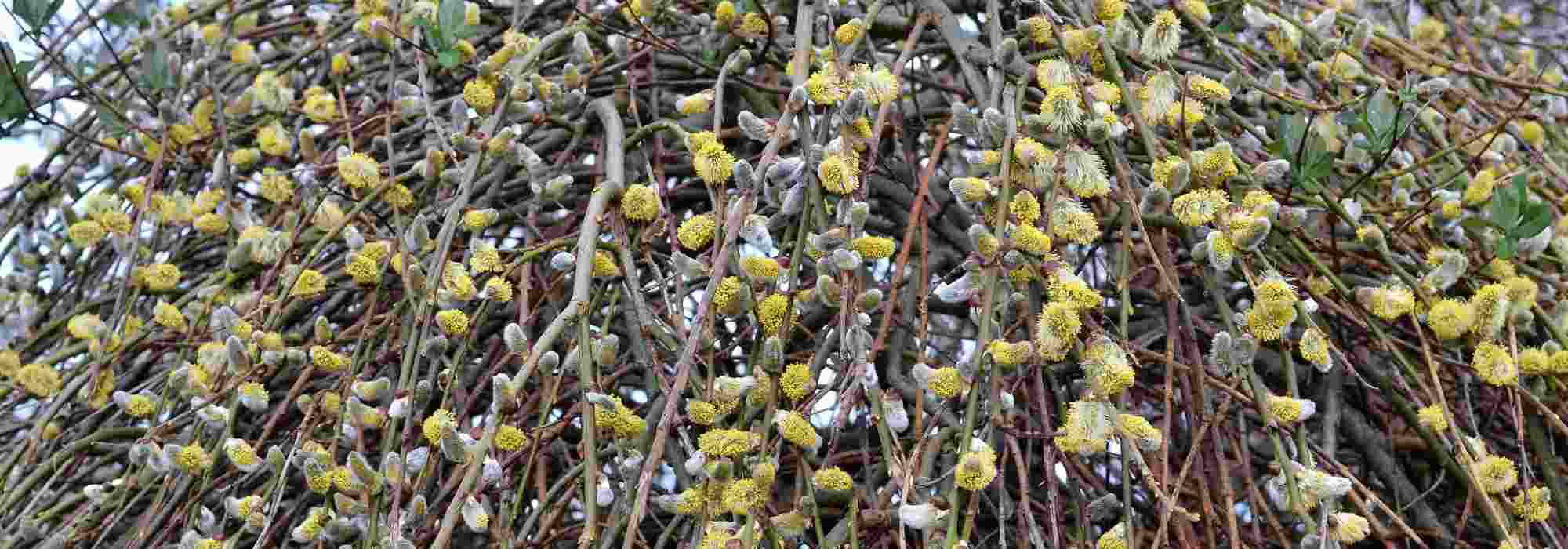
Associate willows
Discover our 5 ideal scenes to enhance the charm of willows.
Contents
Willows Salix in Latin offer a great diversity ranging from the romantic weeping willow to the small creeping dwarf willow and including the elegant pink shrimp weeping willow with its soft pink foliage.
Very hardy, willows grow with great ease, quickly forming remarkable specimens. Willows tolerate annual pruning but can also grow freely to express their habit. The weeping willow or twisted willow, like the dwarf willow, all have decorative foliage and aments. The majority of them adapt to any fresh soil and tolerate exposure ranging from full sun to partial shade. We invite you to discover our 5 pairing ideas featuring three varieties of willows.
To avoid any failure, we recommend planting with the help of our web application Plantfit.
In a rockery
The Salix repens is a creeping willow with a very spreading habit. Ideal for rockeries or slopes. It does not exceed 70-80 cm in height, spreading through suckers. The deciduous foliage consists of small, glossy dark green leaves on the top, while the underside is a more glaucous colour, covered in silver bristles. Flowering occurs from March to May.
The Salix lanata, or woolly willow, is a compact, bushy shrub with a spreading habit. Its foliage, covered in soft grey-silver down, adorns its very decorative young yellow stems. Its large golden male aments and quite spectacular grey-yellow female aments appear in spring.
The Salix hastata ‘Wehrhahnii’, selected for its floribundity, is a delightful little bushy willow that is wider than it is tall. It develops numerous wine-red stems and is adorned in spring with an abundance of large silver aments, edged in gold at ripeness, alongside its green, downy foliage.
At the base of the willow you choose, contrasting with the softness of their appeal, install a carpet of Sedum ‘Sunsparkler Dazzleberry’ in bluish-grey or slate blue, adorned with small raspberry-pink fluffy flowers. In spring, the Bulbocodium vernum with rose-violet flowers resembling a colchicum enlivens the rockery from the end of February.
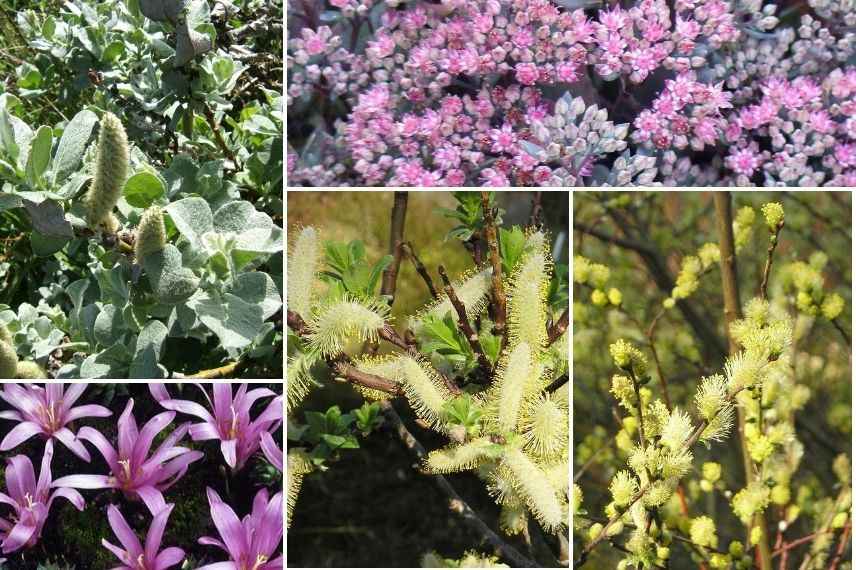
On a pink carpet of Sedum ‘Sunsparkler Dazzleberry’ and Bulbocodium vernum, the bluish-grey foliage of the woolly willow Salix lanata on the left and the fluffy golden aments of Salix hastata in the centre, with Salix repens on the right.
In a woodland
The Salix alba ‘Chermesina’ (synonym Salix alba var. britzensis) with its lovely decorative wood in winter benefits from pruning to encourage the emergence of its coppery orange-red branches. From spring to autumn, it adorns itself with glossy foliage that captures light in a unique way.
The Salix fargesii is a highly decorative Chinese species that is more bushy than shrubby. Its large, glossy dark green magnolia-like leaves are stunning. From its young red shoots emerge large buds covered in silver bristles. In winter, its smooth wood displays a beautiful coppery brown and its upright aments are green.
The Willow ‘Golden Sunshine’ in Latin Salix sachalinensis is a vigorous and robust bush. Its rustic silhouette with a bushy, flexible, and delicate habit reflects its spring flowering with delicate aments.
The light foliage of willows allows for the creation of a lovely bright edge scene around the white and green composed of Sanguinaria canadensis and its starry white flowers. On the ground, Luzula sylvatica grass-like groundcover with long, glossy light green persistent stems serves as a backdrop for the white daisy-like flowers of the Aster umbellatus ‘Weisser Schirm’. The Cornus sericea ‘White Gold’ features velvety foliage variegated with green-grey and cream white in spring. The Sambucus nigra Pulverulenta showcases light green foliage broadly splashed with pure white. Its vegetation is adorned in early summer with large fluffy white umbels, followed by edible black berries.
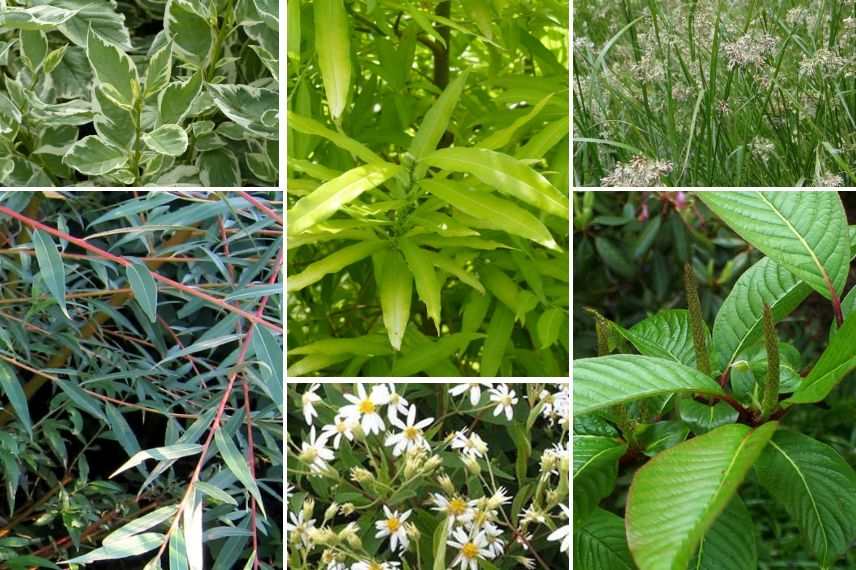
Essence of light, the willow has its place in a woodland edge atmosphere, illuminating it from spring onwards. On the left Salix alba, in the centre the luminous Salix sachalinensis ‘Golden sunshine’, on the right the deceptive foliage of Salix fargesii. The generosity of the foliage of Cornus sericea ‘White Gold’, with the daisy-like flowers of Aster umbellatus ‘Weisser Schirm’ above the grassy carpet of Luzula sylvatica
Discover other Willow - Salix
View all →Available in 1 sizes
Available in 1 sizes
Available in 1 sizes
Available in 1 sizes
Available in 1 sizes
Available in 1 sizes
Available in 1 sizes
Available in 1 sizes
Available in 2 sizes
Available in 2 sizes
To dress a bank
The Salix cinerea, or grey willow, is a large deciduous bush. Well-branched from the base, it develops young, velvety grey shoots and bears lovely silver aments in spring. Its beautiful silky foliage, grey with a bluish underside, flourishes in the sun in ordinary soil. This fast-growing bush reaches a height of no more than 4 m and a spread of 3 m.
The Salix exigua has grey foliage that forms an upright crown. This wild-looking species is very elegant and tolerant of various soil types. It thrives on a bank, helping to retain the soil.
The Salix aurita is a small bushy willow that flowers in spring. It acts as a windbreak and withstands salt spray.

From left to right, Salix cinerea, S. exigua, S. aurita. Three wild willows that sucker for banks and slopes. Remember to cut them back to enjoy them fully for a long time.
The wild appearance of the willows frames this summer scene composed of the long silver plumes of the Stipa pennata ssp pulcherrima and a multitude of dark purple flower spikes with the Sanguisorba officinalis ‘Red Thunder’. The Salvia nemorosa ‘Schwellenburg’ with its purple-pink flowers harmonises with the pale mauve slightly pinkish spikes of Salvia nemorosa ‘Amethyst’. The Cotinus coggygria ‘Smokey Joe’ adds its feathery pink flowering and bronze foliage in autumn.
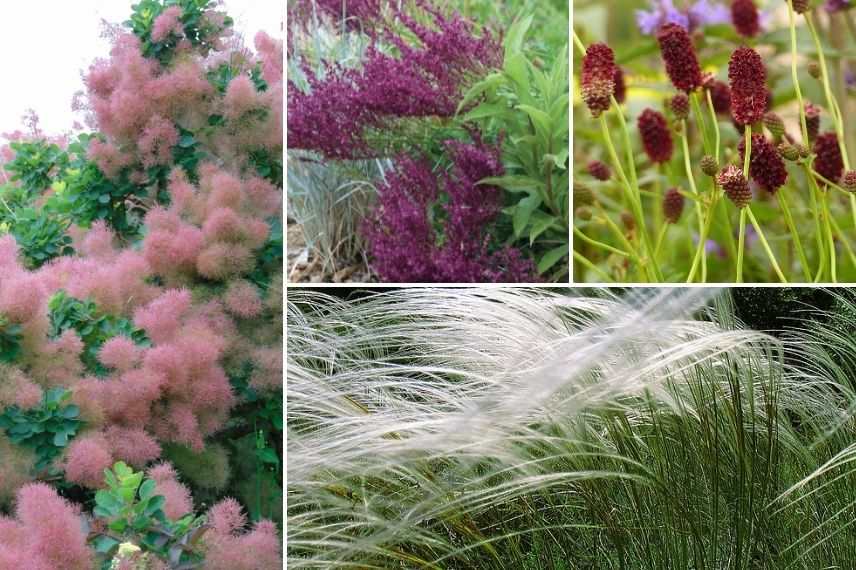
Around the feathery smoke tree Cotinus coggygria ‘Smokey Joe’ on the left, a palette of ruby pink with the salvias and the spikes of the sanguisorba above, amidst the transparency of the plumes of Stipa pulcherrima.
Read also
How to make willow water?By the edge of a water body
The Salix matsudana Tortuosa is a highly decorative willow with spiralled branches and twisted olive green leaves, reaching heights of up to 10 m. In March, it produces long greyish-white aments. The Salix erythroflexuosa is a weeping and twisted willow, covered in a light orange-red bark. It bears narrow, curled, and twisted leaves. Of modest stature, it remains decorative throughout the year, particularly by the edge of a water feature where it will make a striking impression.
The Shrimp Willow, Salix integra ‘Hakuro Nishiki’ is a living spectacle, multicoloured and ever-changing. Extremely decorative from spring to autumn, it showcases pink and soft green in spring, followed by white and green in summer. Its bright green branches take on a lovely dark red hue in winter. In spring, tiny pinkish-red flowers emerge in small spikes amidst the dark pink foliar buds that unfold into small shrimp-coloured leaves.
The flexible branches of the shrimp willow cascade to the ground where tufts of Chasmanthium latifolium with light green foliage bear small green-brown spikes that hang delicately. The pink hues of the shrimp willow complement the flowering of Chelone obliqua and the carmine flower spikes of Primula vialii creating an exotic display in early summer. By the water’s edge, place the Butomus umbellatus accompanied by its white to pink or light red, fragrant flower umbels.
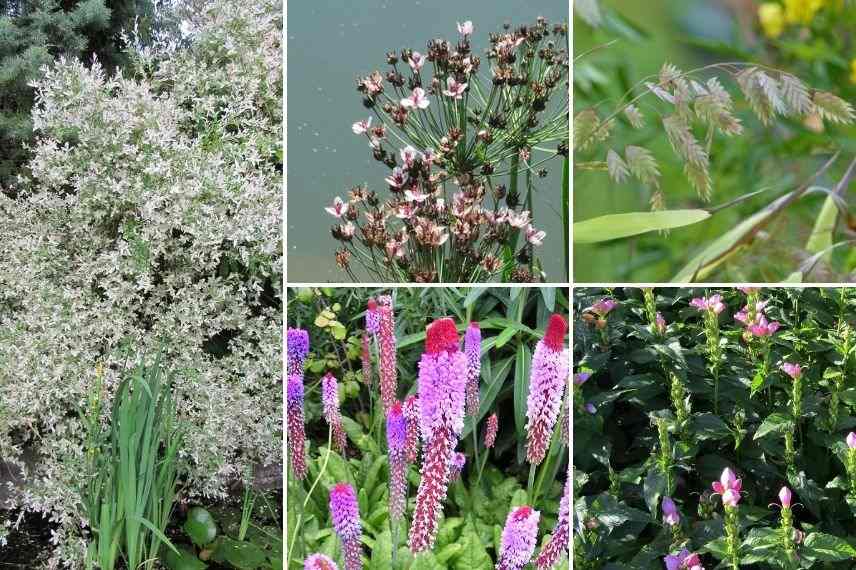
The shrimp willow, a mosaic of colour and light, mingles with the magenta spikes of Primula vialii and Butomus umbellatus in the centre. To the right, the graceful spikes of Chasmanthium latifolium and the deep pink flowering of Chelone obliqua
In a container on a balcony or terrace
Three Irresistible Willows for a Terrace in pots, thanks to their striking appearance and colour. The Salix tetrapla is a small-growing willow that is suitable for pot cultivation. It produces yellow aments in spring and reveals its beautiful branches in shades of yellow to golden brown in winter. Prune it regularly after flowering to encourage it to thicken and produce numerous colourful shoots.
The Salix caprea ‘Kilmarnok’, grafted at the top, with a weeping habit, features a crown of long trailing branches that reach the ground. Its branches are adorned with decorative silver and velvety yellow aments in late winter. It is perfectly suited for pot cultivation on the terrace.
The Salix subopposita is a bushy shrub with a bonsai-like appearance, appreciated for its lovely compact habit and remarkable spring flowering in March-April. Its silver aments, followed by golden ones, literally cover its upright branches, followed by the velvety foliage of a soft grey-green. This small willow will not exceed 1 m in height and 1.20 m in spread.
In spring, enjoy the spectacle of flowering willows alongside the fragrant blooms of a Chimonanthus praecox. Place pots of Crinum asiaticum for their delicately scented white lily-like flowers. The colourful purple evergreen foliage of the Berberis Thunbergii ‘Bagatelle’ is adorned in spring with pale yellow flowers tinged with red, harmonising with the Alopecurus pratensis ‘Aureovariegatus’, a lovely grass with variegated green and golden leaves.
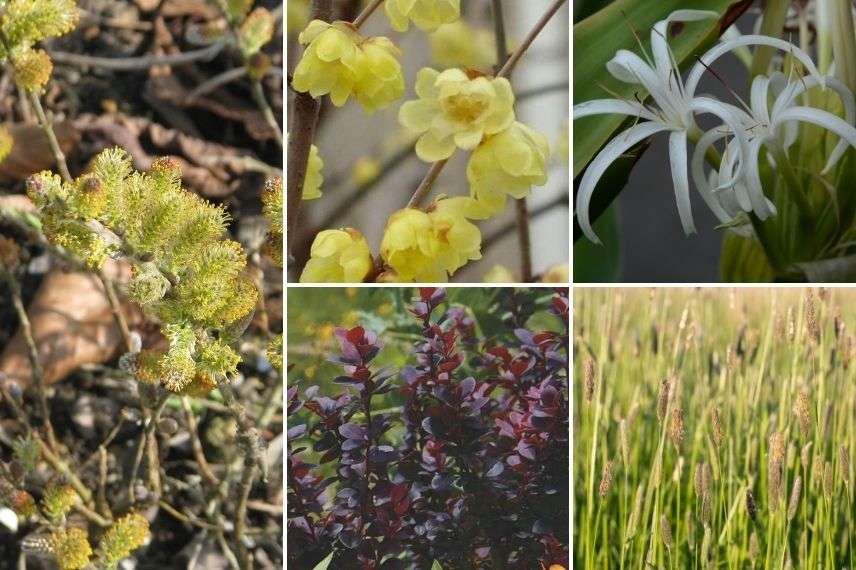
Elegance of the aments of the subopposita willow on the left, above the fragrant blooms of the Chimonanthus praecox and Crinum asiaticum. Below, the colourful foliage of the Alopecurus and Berberis ‘Bagatelle’.
For further reading
Eric’s advice: Willows such as Salix sachalinensis ‘Sekka’ or Salix chaenomeloides ‘Mount Aso’ can be pruned back to the ground in winter to encourage the regrowth of colourful young shoots and their decorative foliage.
Indeed, willows tend to develop a woody formation through regular pruning of the previous season’s shoots (topping), which radically alters the light effect of their natural silhouette. Discover all our tips in our comprehensive guide. Willows, Salix: Planting, pruning, and maintenance.
- Subscribe!
- Contents


































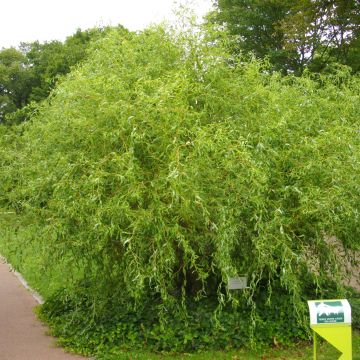
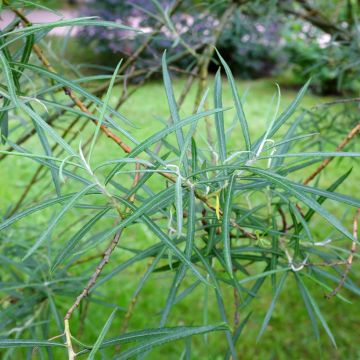
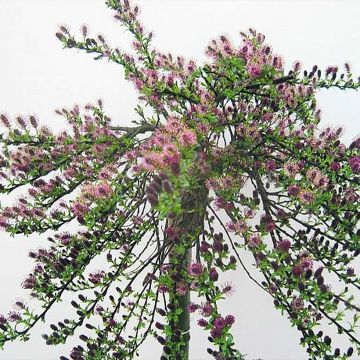
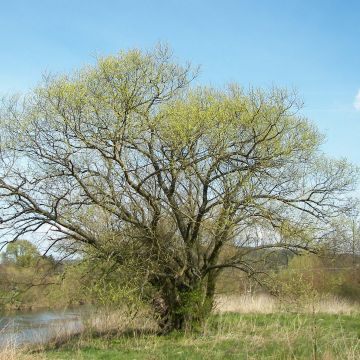
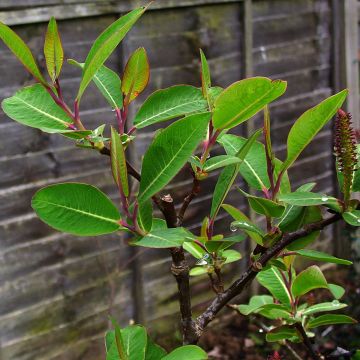

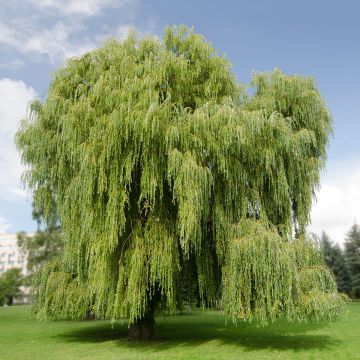
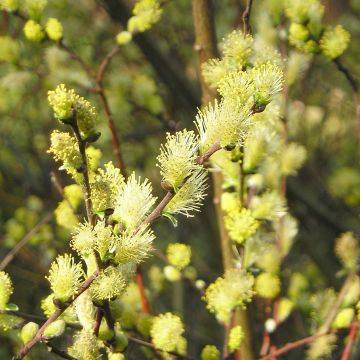
Comments